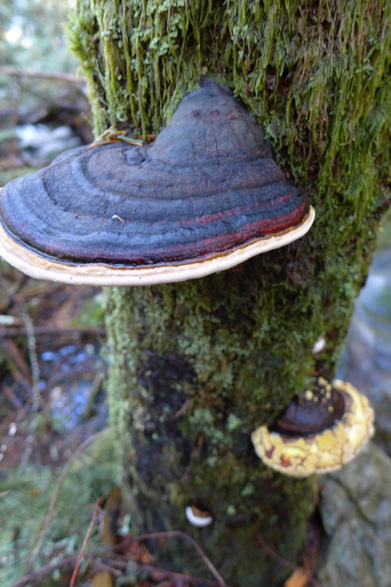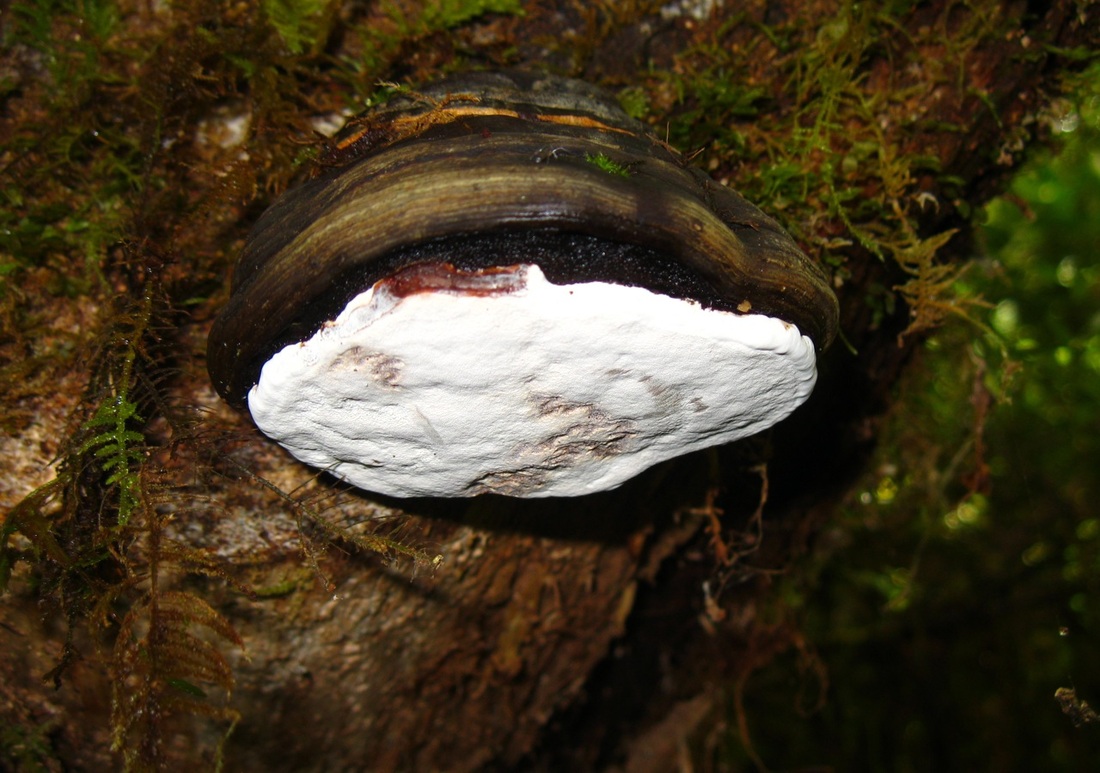Artist's conk • Ganoderma applanatum
Identification
This bracket fungus is shelf-like and very hard. The dull (not shiny) grey to brownish upper surface of the fungus has a rough, woody texture, with crusty layers that can become cracked or furrowed. The spores on the underside are white but bruise dark when scratched. The stalkless cap is 5-50 cm wide and varies from a steep hoof-like shape to flat or convex.
Habitat & Range
Artist's conk grows on dead and decaying trees, and on wounds in live trees. This fungus is abundant and very widespread across North America. It is also found in Europe and Central America.
Similar Species
There are similar Ganoderma species that grow in the same manner as G. applanatum, but they are distinguished by their smooth shiny upper surfaces, while the upper surface of Artist's conk is rough and furrowed. Take care not to confuse artist's conk with Fomitopsis species, as significant variation occurs in both. Similar species also tend to lack the easily-bruised white spores of artist's conk.
Human Uses
In traditional Chinese medicine all Ganoderma species are valued for their medicinal properties. In Western culture the medicinal potential of this fungus is relatively underappreciated, and its main human use is as a blank canvas for etched artwork. By scratching the bottom of the fungus a skilled artist can leave a detailed and lasting image.
Intriguing Info
This fungus is widespread, probably because each one releases 30 billion spores per day! The fruiting bodies of the fungus is perennial and over the years can reach a massive size. The hyphae threads can cause a white rot in living trees; this rot can be deadly to the host tree.
This bracket fungus is shelf-like and very hard. The dull (not shiny) grey to brownish upper surface of the fungus has a rough, woody texture, with crusty layers that can become cracked or furrowed. The spores on the underside are white but bruise dark when scratched. The stalkless cap is 5-50 cm wide and varies from a steep hoof-like shape to flat or convex.
Habitat & Range
Artist's conk grows on dead and decaying trees, and on wounds in live trees. This fungus is abundant and very widespread across North America. It is also found in Europe and Central America.
Similar Species
There are similar Ganoderma species that grow in the same manner as G. applanatum, but they are distinguished by their smooth shiny upper surfaces, while the upper surface of Artist's conk is rough and furrowed. Take care not to confuse artist's conk with Fomitopsis species, as significant variation occurs in both. Similar species also tend to lack the easily-bruised white spores of artist's conk.
Human Uses
In traditional Chinese medicine all Ganoderma species are valued for their medicinal properties. In Western culture the medicinal potential of this fungus is relatively underappreciated, and its main human use is as a blank canvas for etched artwork. By scratching the bottom of the fungus a skilled artist can leave a detailed and lasting image.
Intriguing Info
This fungus is widespread, probably because each one releases 30 billion spores per day! The fruiting bodies of the fungus is perennial and over the years can reach a massive size. The hyphae threads can cause a white rot in living trees; this rot can be deadly to the host tree.
References
Arora, D. (1991). All That the Rain Promises and More…. New York: Ten Speed Press. P. 194
Kuo, M. (2004). Ganoderma applanatum. MushroomExpert.Com. Accessed 06/26/2014.
Authors and editors of page
Fin Smith, Kelly Fretwell, and Brian Starzomski (2014).
Arora, D. (1991). All That the Rain Promises and More…. New York: Ten Speed Press. P. 194
Kuo, M. (2004). Ganoderma applanatum. MushroomExpert.Com. Accessed 06/26/2014.
Authors and editors of page
Fin Smith, Kelly Fretwell, and Brian Starzomski (2014).






